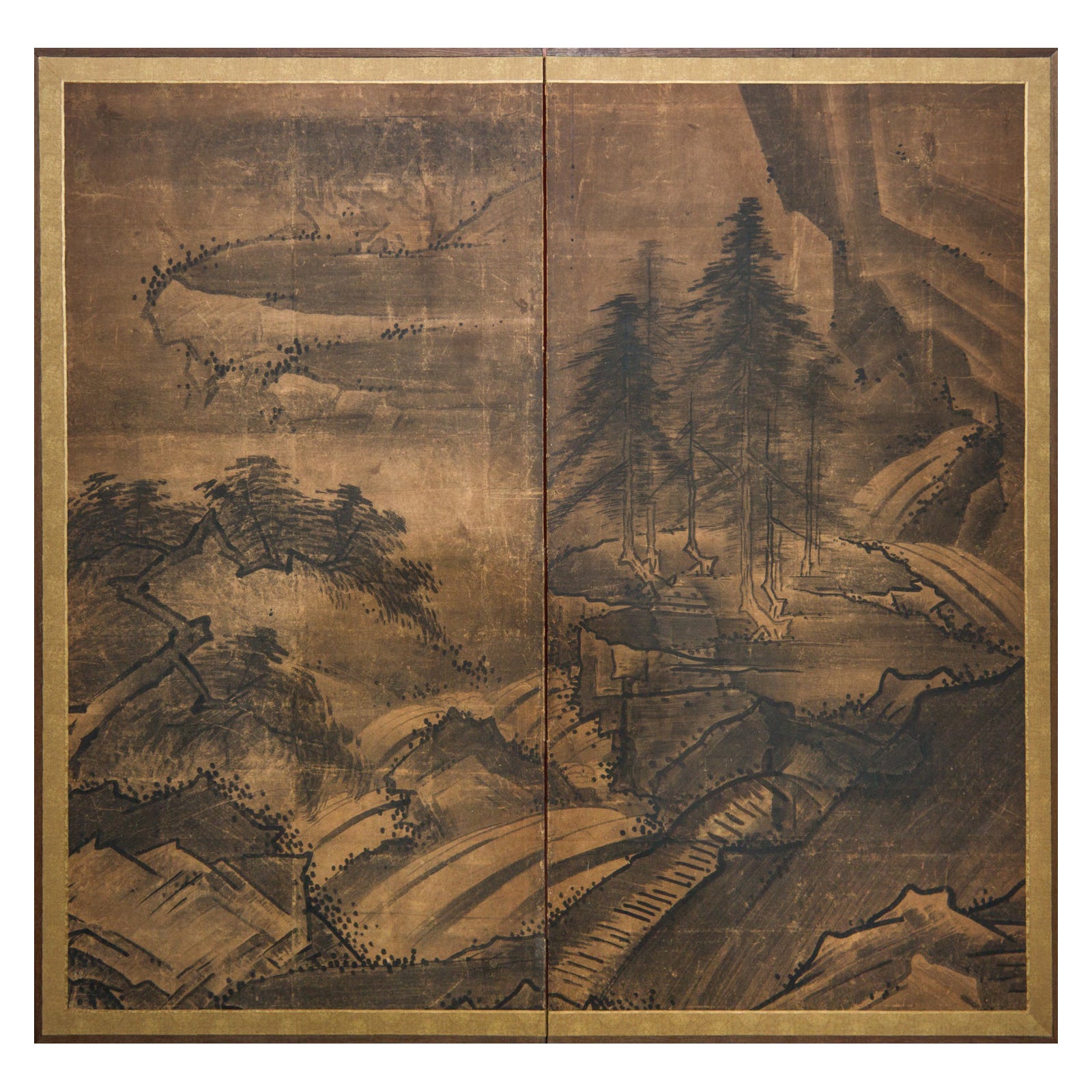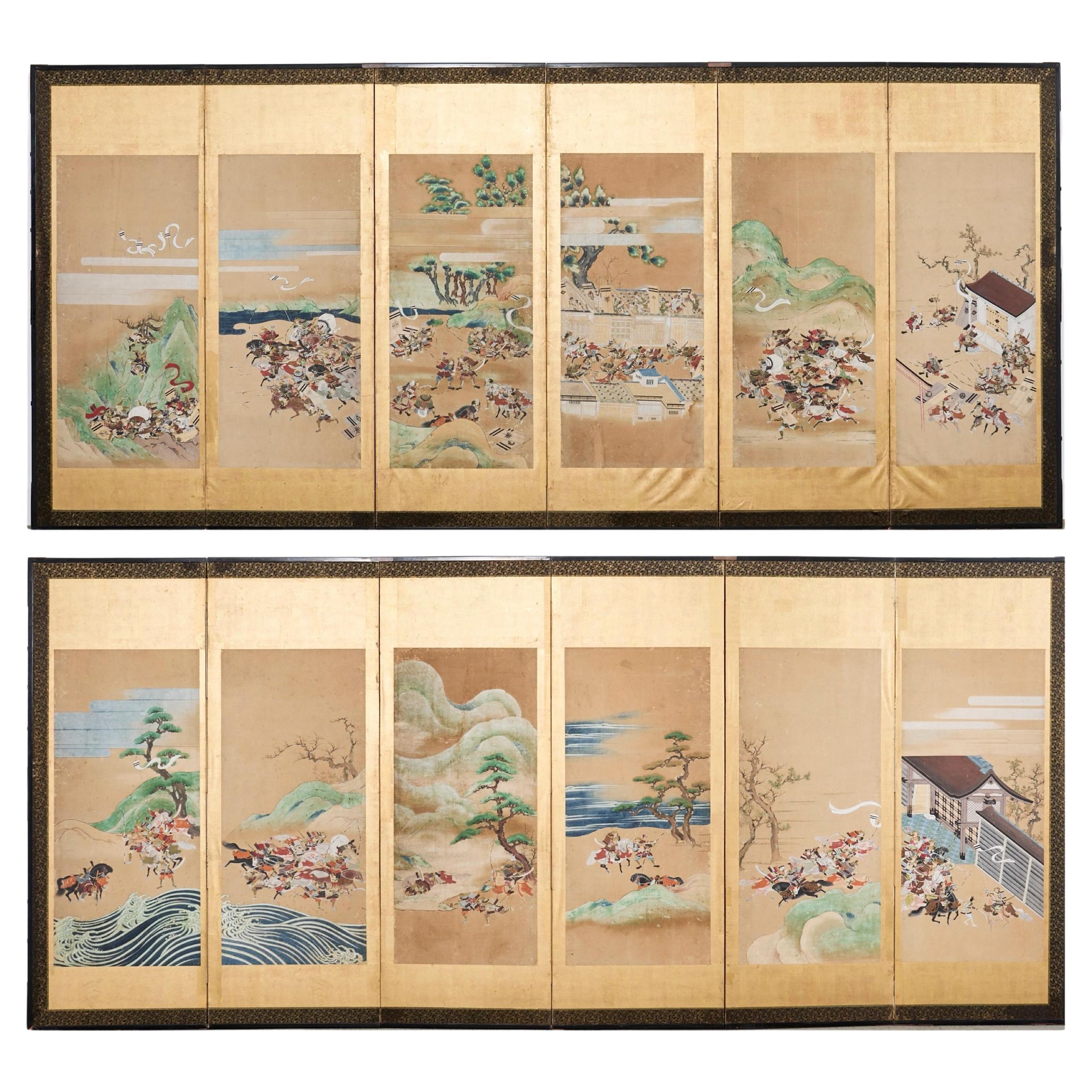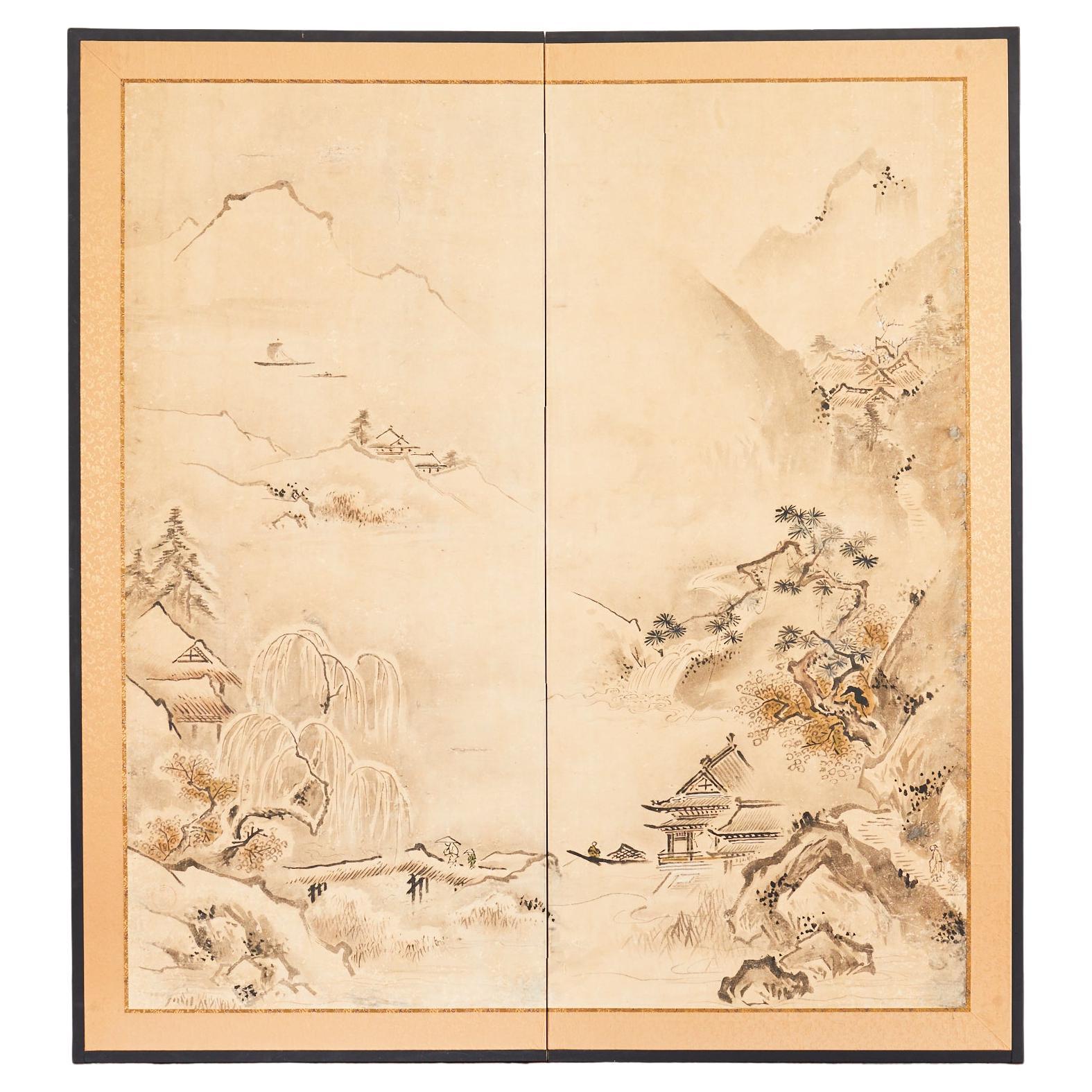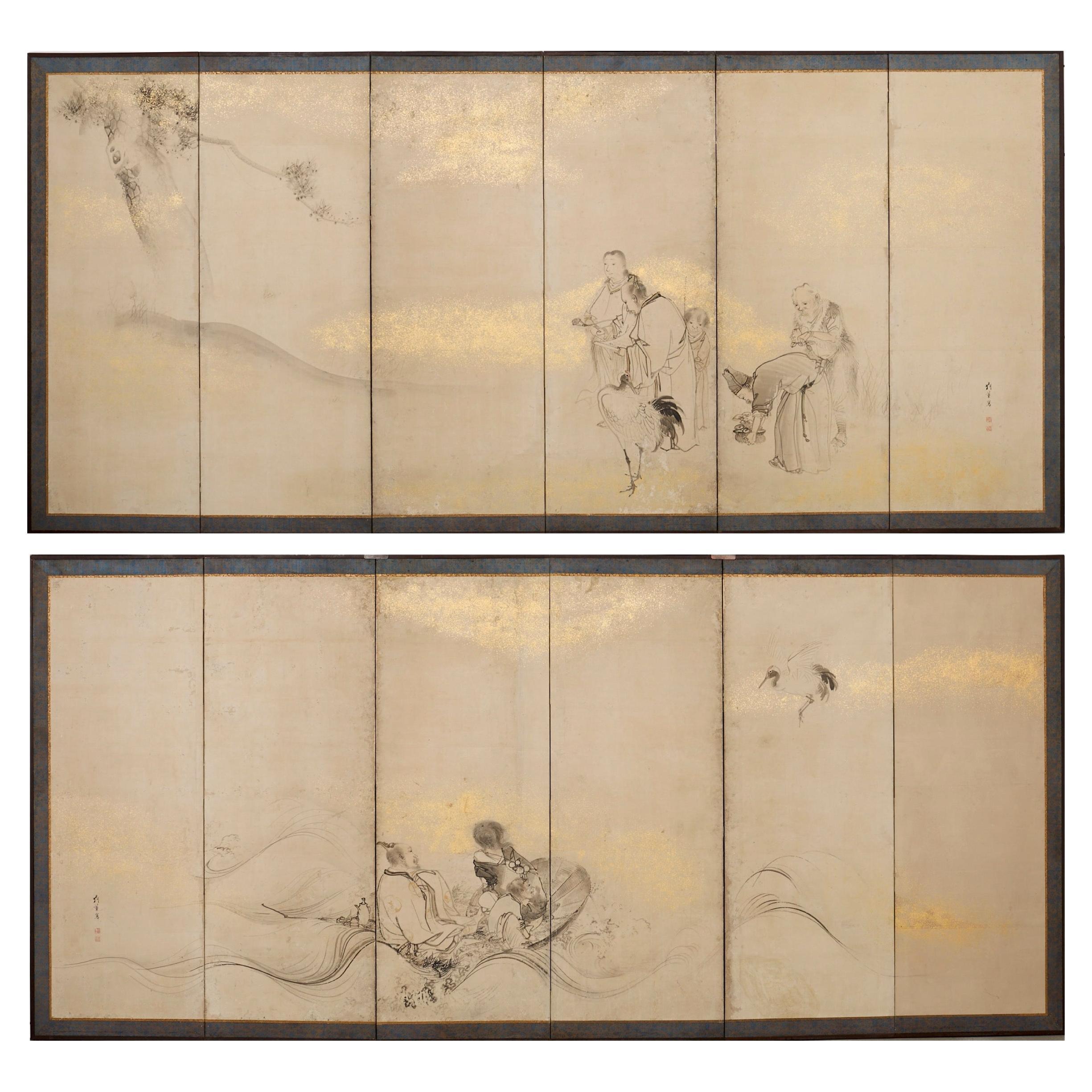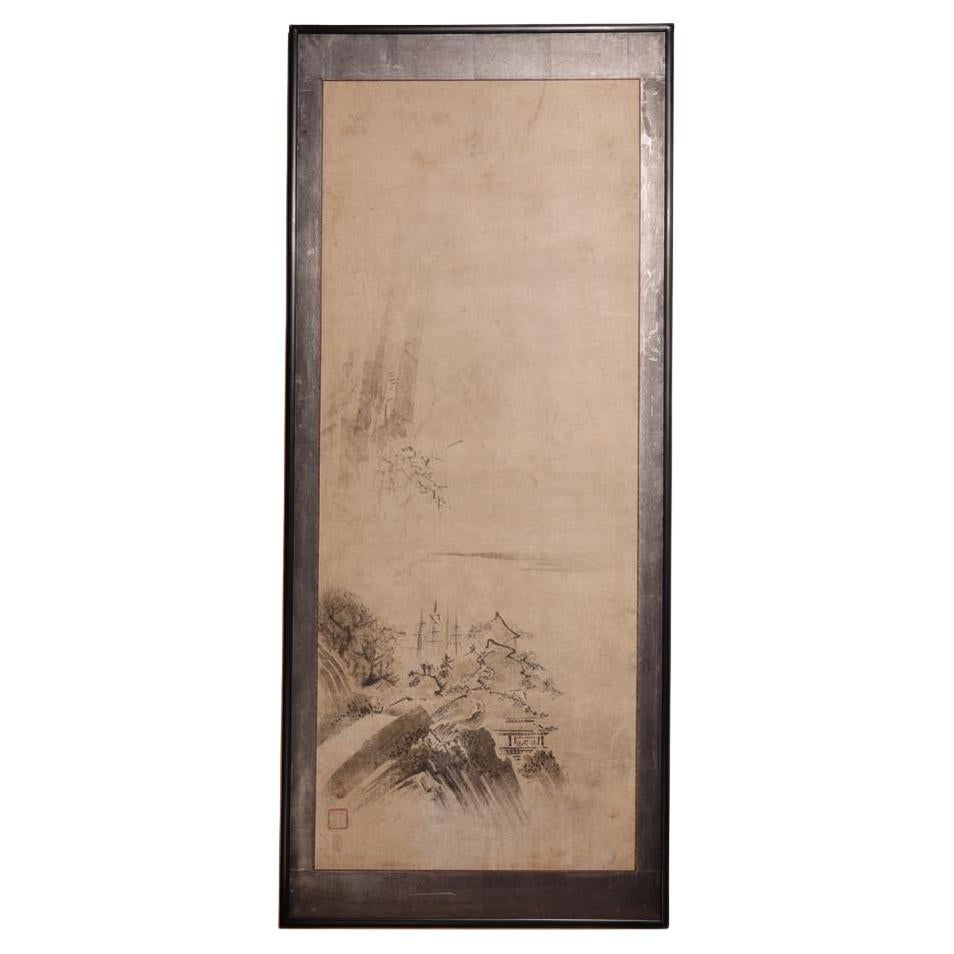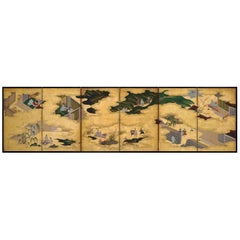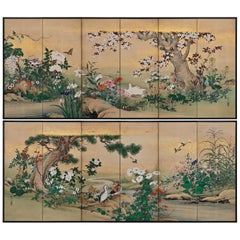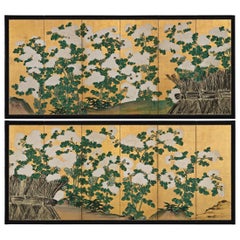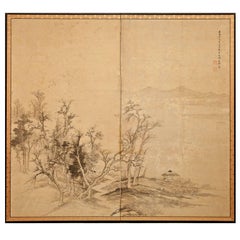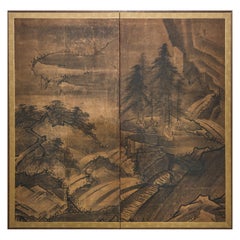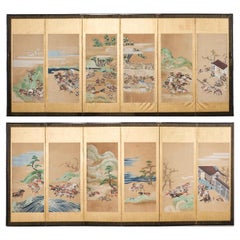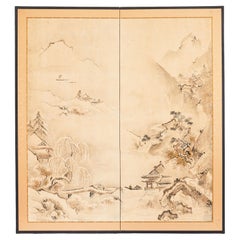Items Similar to 17th Century Japanese Screen. View of West Lake by Unkoku Toyo.
Want more images or videos?
Request additional images or videos from the seller
1 of 21
17th Century Japanese Screen. View of West Lake by Unkoku Toyo.
$85,000per set
£63,954.60per set
€73,868.92per set
CA$120,127.19per set
A$130,356.31per set
CHF 69,077.36per set
MX$1,598,756.67per set
NOK 854,827.32per set
SEK 807,766.56per set
DKK 551,468.36per set
About the Item
Unkoku Toyo (1612-1668)
View of West Lake
Pair of eight-panel Japanese Screens. Ink and gold wash on paper.
Dimensions: Each screen: H. 110 cm x W. 372 cm (43” x 147”)
This pair of Japanese landscape screens, by Unkoku Tōyō (1612–1668), presents a striking interpretation of the famous West Lake in Hangzhou. Rooted in the Sesshū Tōyō tradition, the screens capture the spirit of Chinese landscape painting through the lens of Japanese artistic sensibilities.
The two screens together create a continuous, wide-angle landscape, segmented across folding panels. This format encourages the viewer to "travel" visually through the scene, almost like a hand-scroll painting. Despite the large scale, there's meticulous detail in the architecture, boats, and foliage. Subtle ink gradations suggest mist, atmosphere, and spatial recession. The painting idealizes a legendary Chinese landscape, stirring feelings of admiration and longing for a cultural "golden age." The serene water, mist-veiled mountains, and distant temples evoke a deep sense of peace and reflection. The painting employs ink wash on paper with an atmosphere of antiquity and subtlety. Gold wash in the background adds warmth and elegance.
The Unkoku family began when the feudal lord Mori Terumoto installed the painter Togan in Sesshu’s atelier Unkokuan, with Togan subsequently adopting the family name ‘Unkoku.’ The members of the Unkoku school were retainers of the Mori clan, so art historians assume its painters were based around the Yamaguchi area, though some were also active in Kyoto. For example Unkoku Toyo produced sliding door paintings for the Hekigyoku-an sub temple of Daitokuji in Kyoto. Together with his younger brother Toji and others, Toyo also participated in decorating the Imperial Palace after its reconstruction in 1655. He also left behind works at Manpukuji, the head temple of the Obaku zen school.
The screens are magnificently mounted and presented to the highest level. They are preserved in an old wooden storage box. The inscription pasted on the inside of the box lid is written by Kanda Nobuhisa (d.1862). The upper section of the inscription details that this pair of ink landscape screens were presented to Emperor Kokaku (1771-1840) and concubine Kanshuji Tadako (1780-1843) in honor of their daughter, Princess Haru (1817-1819). Princess Haru was the fourth daughter of Emperor Kokaku. The lower section of the inscription details that this pair of screens were gifted to the Kyoto Sento Imperial Palace in the year Tenpo 4, 1833. The screens were given in honor of Emperor Kokaku’s fourth daughter, Princess Haru (1817-1819). The Kanda family were a very powerful aristocratic family with a documented connection to the Kanshuji family. The Kyoto Sento Imperial Palace was ravaged by fire in 1854 and no longer stands in its original form.
Also accompanying the pair of screens are three photographs. Two of them depict the screens displayed in an early 20th century Japanese interior. The other is a family photograph with an inscription on the reverse reading: “Taisho 7 (1918), 29 years old, donation”. Presumably the screens were donated to the daughter of this aristocratic family in 1918.
- Dimensions:Height: 43 in (109.22 cm)Width: 147 in (373.38 cm)Depth: 0.75 in (1.91 cm)
- Sold As:Set of 2
- Style:Edo (Of the Period)
- Materials and Techniques:
- Place of Origin:
- Period:Mid-17th Century
- Date of Manufacture:Circa 1650
- Condition:Wear consistent with age and use.
- Seller Location:Kyoto, JP
- Reference Number:1stDibs: LU2472345406182
About the Seller
5.0
Recognized Seller
These prestigious sellers are industry leaders and represent the highest echelon for item quality and design.
Established in 2001
1stDibs seller since 2016
72 sales on 1stDibs
Typical response time: 16 hours
- ShippingRetrieving quote...Shipping from: Kyoto, Japan
- Return Policy
Authenticity Guarantee
In the unlikely event there’s an issue with an item’s authenticity, contact us within 1 year for a full refund. DetailsMoney-Back Guarantee
If your item is not as described, is damaged in transit, or does not arrive, contact us within 7 days for a full refund. Details24-Hour Cancellation
You have a 24-hour grace period in which to reconsider your purchase, with no questions asked.Vetted Professional Sellers
Our world-class sellers must adhere to strict standards for service and quality, maintaining the integrity of our listings.Price-Match Guarantee
If you find that a seller listed the same item for a lower price elsewhere, we’ll match it.Trusted Global Delivery
Our best-in-class carrier network provides specialized shipping options worldwide, including custom delivery.More From This Seller
View AllJapanese Screen Painting, Circa 1700 'Tales of Ise' by Tosa Mitsusuke
By Tosa Mitsusuke 1
Located in Kyoto, JP
A six-fold Japanese screen by Tosa Mitsusuke (1675-1710), Japan 17th-18th century, Edo period.
The signature reads Shoroku-i ge Tosa sa Konoe Shogen Mit...
Category
Antique Late 17th Century Japanese Edo Paintings and Screens
Materials
Gold Leaf
Late 17th Century Japanese Screen Pair. Battle of Ichi-no-tani and Yashima.
Located in Kyoto, JP
Anonymous
Late 17th Century
Battle of Ichi-no-tani & Yashima
Dimensions: Each Screen: H. 175 cm x W. 385 cm (69” x 151.5”)
This pair of Japanese screens depict two significant battles from the Genpei War (1180–85), as recounted in the Tale of the Heike, a semi-historical epic chronicling the conflict between rival clans for control of Japan, written in the early 1200s.
Each screen portrays a single battle through a series of small episodes, framed by gold clouds, landscape elements, and architectural features. True to the style of many screens inspired by The Tale of the Heike, the scenes are rendered in lavish colors and gold, downplaying the brutality of the warfare. Although based on real events, these narratives often glorified and romanticized the heroic feats of the warriors. Viewers at the time would have been familiar with the story’s details, leading to a proliferation of paintings on folding screens inspired by this theme from the late Muromachi to the early Edo periods.
On the right screen, we see the Minamoto’s attack on the Taira, who have retreated from the capital, Kyoto, toward the sea. The central building represents the temporary Taira headquarters, where Taira soldiers are holding the young Emperor Antoku. The Minamoto plan to launch a surprise attack from the rear after descending the steep cliff known as Ichi-no-tani, depicted at the top center. This scene highlights the tactical brilliance of Minamoto commander Yoshitsune and the courage of his men.
The left screen captures moments from the Battle of Yashima...
Category
Antique Late 17th Century Japanese Edo Paintings and Screens
Materials
Gold Leaf
19th Century Japanese Screen Pair. Flowers & Birds of the Four Seasons
Located in Kyoto, JP
Flowers & Birds of the Four Seasons
Pair of six-fold Japanese Screens. Ink, color, gofun and gold on paper.
Second half of the 19th Centur...
Category
Antique Late 19th Century Japanese Meiji Paintings and Screens
Materials
Wood, Paper
Mid-18th Century Japanese Screen Pair, One Hundred Flowers, Chrysanthemums
Located in Kyoto, JP
Omori Soun (b. 1704)
Chrysanthemums - One Hundred Flowers
A Pair of Six-fold Japanese Screens. Ink, color, gofun and gold leaf on paper.
Dating ...
Category
Antique Mid-18th Century Japanese Edo Paintings and Screens
Materials
Gold Leaf
18th Century Japanese Screen Pair. Plum & Young Pines. Kano School.
Located in Kyoto, JP
Dimensions (Each screen): H. 176 cm x W. 378 cm (69’’ x 149’’)
This pair of Japanese folding screens depict blossoming plum trees amongst young pines. They are designed to capture t...
Category
Antique Late 18th Century Japanese Edo Paintings and Screens
Materials
Gold Leaf
17th Century Japanese Screen Pair by Soga Nichokuan, Hawks on Pine & Plum Trees
Located in Kyoto, JP
Hawks on plum and pine
Soga Nichokuan (active circa 1625-1660)
Pair of six-fold screens.
Ink, mineral pigments, gofun, gold and speckled gold l...
Category
Antique 1640s Japanese Edo Paintings and Screens
Materials
Wood, Paper
You May Also Like
Japanese Two-Panel Screen: Ink Landscape on Silk
By Shunyu
Located in Hudson, NY
Japanese Two Panel Screen: Ink Landscape on Silk, Meiji period (1868 - 1912) painting of a man riding a mule on a pathway through the Kurotani mountains with a thatched roof shelter ...
Category
Antique 19th Century Japanese Meiji Paintings and Screens
Materials
Silk, Wood
Japanese Two Panel Screen Suiboku Landscape in Sesshu Style
Located in Hudson, NY
Suiboku is a style of ink painting that is reminicent of the way calligraphers paint. Masterfully painted Muromachi Period (1336-1573) painting, unique in style and strength for the period with very bold lines. Sesshu Toyo...
Category
Antique 16th Century Japanese Paintings and Screens
Materials
Silk, Paper
Pair of Japanese Edo/Tokugawa Screens Tale of Heiki
Located in Rio Vista, CA
Monumental pair of late 18th century Japanese Edo/Tokugawa period byobu screens depicting the battles between Taira and Minamoto. The screens have six panels each with individual sce...
Category
Antique 19th Century Japanese Edo Paintings and Screens
Materials
Brass, Gold Leaf
Japanese Meiji Two-Panel Screen Chinese Country Winter Landscape
Located in Rio Vista, CA
Late 19th / early 20th century Japanese Meiji period two-panel folding byobu screen featuring a winter landscape with a Chinese country villa and distant village. Kano School screen ...
Category
Antique 19th Century Japanese Meiji Paintings and Screens
Materials
Brass
Pair of 18th Century Japanese Edo Screens of Chinese Immortals
Located in Rio Vista, CA
Mesmerizing pair of late 18th/early 19th century Japanese Edo period byobu screens by Shibata Gito (Japanese 1780-1819). The paintings depict Chinese immortals in a dreamy landscape....
Category
Antique 18th Century Japanese Edo Paintings and Screens
Materials
Silk, Wood, Paper
Antique Japanese Suibokuga Landscape by Kano Tokinobu, 17th century.
Located in Point Richmond, CA
Antique Japanese Suibokuga Landscape by Kano Tokinobu, 17th century. A sumi-e ink on paper painting illustrating a rocky seaside landscape containing buildings, vegetation and ship masts. The painting with 3 vermillion seals of the artist in the lower left corner. Japanese dry mount paper on a wood frame with thin brocade border silver leafed surround and lacquered wood outer frame.
Condition: Lighter discoloration near the bottom of the painting, various paper restorations, other minor signs of age, wear, stains, otherwise fine condition.
Age: Painting Edo Period, circa 1670. Mounting circa 1985.
Image: 51-1/2 in. x 20-1/2 in. (131cm x 52cm)
Frame: 59-1/4 in. x 25-1/4 in. (150cm x 64cm)
Weight: 6 lbs.
Provenance:
with Honeychurch Antiques...
Category
Antique 1670s Japanese Edo Paintings and Screens
Materials
Paper
More Ways To Browse
Mid Century Screen
Wooden Storage Boxes
Hand Painted 4 Panel Screen
Antique Wooden Storage Box
Pair Of Japanese Screens
17th Century Japanese Paintings
Asian Hand Painted 4 Panel Screen
17th Century Japanese Screens
Eight Panel Screen
Painted 4 Panel Screen Chinese
Toyo Japan
4 Panel Hand Painted Japanese Screens
Japanese Folding Screen 4 Panels
4 Panel Japanese Gold Screen
Old Antique Wooden Boxes
Japanese Edo Screen 4 Panels
Chinese Lattice
Japanese Screen Black

